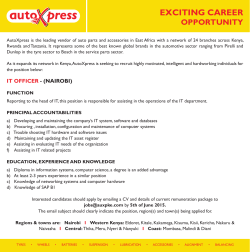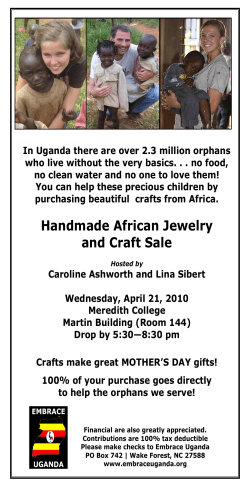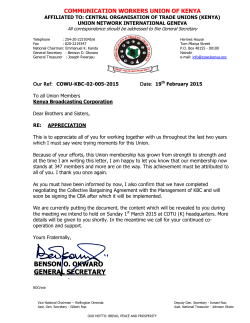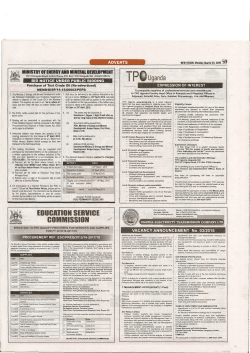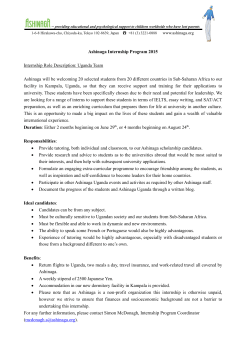
âJustâ $6 a month?: The World Bank will not end poverty by
KENYA SECTION|Since 1959 “Just” $6 a month?: The World Bank will not end poverty by promoting fee-charging, for-profit schools in Kenya and Uganda Response to President Jim Kim’s speech from concerned communities and organisations in Kenya and Uganda © Xavier Bourgois Snapshot of the living conditions in one of Kenya’s informal settlements in which Bridge International Academies operate. “It is not just $6. It goes a long way.” In his speech of 7th April 2015 titled “Ending Extreme Poverty by 2030: The Final Push” delivered ahead of the 2015 World Bank/IMF Spring Meetings, the president of the World Bank, Jim Yong Kim, praised the for-profit, feecharging chain of private primary schools based in Kenya and Uganda, Bridge International Academies (BIA).1 He argues that thanks to these academies, where nearly 120,000 pupils are enrolled, “[a]fter about two years, 1 See http://bit.ly/1NR4wH8. 1 students’ average scores for reading and math have risen high above their public school peers”. And these results, he said, are achieved for “just” $6 dollars a month. The figure given of $6 is not accurate. Schools fees at BIA range from about $6.5 to $9, depending on the grade.2 To this should be added the cost of uniforms, sold by Bridge, which cost about $18.5 per year, the equivalent of another $2 per month over 9 months, and exam fees of $2 to $3 per term. Other costs for textbooks, payment transfers, or other items may be added, and so a conservative estimate of the real monthly amount received by BIA for each child ranges rather between $9 and $13 a month – excluding food, which BIA provides for an additional $7 per month. The total monthly bill including school meals thus ranges between $16 and $20. Nevertheless, even assuming a cost of $6 per month, the speech reveals the World Bank’s profound lack of understanding of the reality of poor people’s lives. When President Kim argues that schooling at Bridge costs “just” $6, the underlying message is that $6 a month is a small amount of money worth paying for schooling, even in contexts of great poverty. Such a statement is ill-informed and dangerous, especially coming from a world leader with the power to influence directions in global development. It is alarming that charging poor people school fees—something that the global community has worked particularly hard to abolish over the last two decades due to their negative impact on the poor—is being promoted as a means of ending poverty. “My honest view is this; if the World Bank was genuinely keen in promoting access to basic education for every child, especially those in vulnerable areas, then they would focus more on supporting and enhancing access to free public primary schools rather than supporting private schools which only operate to make profits out of our poor pockets.” Interview of Hakijamii with a resident of Kibera informal settlement (Africa’s largest Informal settlement) in Nairobi, Kenya, who is also a member of the community based organization “Soweto Forum”. We, civil society organisations and citizens of Kenya and Uganda, are appalled that an organisation whose mandate is supposed to be to lift people out of poverty shows such a profound misunderstanding and disconnect from the lives and rights of poor people in Kenya and Uganda. We, who live in Kenya and in Uganda, can testify that $6 per month is much more money than most of our families, friends, and community members can afford without making huge sacrifices. If the World Bank is serious about improving education in Kenya and Uganda, it should support our governments to expand and improve our public education systems, provide quality education to all children free-of-charge, and address other financial barriers to access. 2 Prices communicated by parents during interviews and officially communicated by BIA. 2 Comments and concerns from Kenya According to the most recent Demographic and Health Survey in Kenya released in 2015, women from poor families record higher birth-rates compared to their counterparts from wealthier families. 3 The poorest families in Kenya today have three times as many children as a wealthy one. Nationally, women from the poorest families were found to have an average of 6.4 children although those aged 19 to 49 had an exceptionally higher fertility rate at an average of 9.4 children each. “Bridge Academies? Those schools, they are for rich people!” © Xavier Bourgois Reaction of a leader of the Mathare Youth Talent Organization (MYTO), a community based organisation, when asked about Bridge Academies in an interview with Hakijamii. Data from the latest 2012/2013 household survey in Kenya show that half of the households in Kenya earn KES 7,000 ($75) or less.4 Thus, for half of Kenyan households, even assuming a cost of $6 a month, sending 3 children of primary school age to a Bridge Academy would cost at least 24% of their monthly income. Taking into account more realistic monthly costs of about $17 that include school meals, sending their children to a Bridge Academy would cost half Kenyan households at least 68% of their monthly income. But it’s often more. 47% of Kenya’s population live below the poverty line, and for some counties in the rural areas the poverty rates escalate to as high as 70%.5 This means that for 47% of the population, any expenditure to access education, even $6, means sacrificing another essential right for their survival, such as health, food, or water. A recent study commissioned by the United States Agency for International Development (USAID) and implemented in 2012 - 2014 by Concern Worldwide Kenya further shows that in five urban informal settlements where BIA has schools, households spend on average 63.8% of their income on food.6 Thus, for most people living in slums, any expense towards education, even $6, is a threat to their food security. This particularly affects women-headed households, which have lower income, and up to 74% of which are severely food insecure. 3 Kenya Demographic and Health Survey (KDHS) report released on 2/4/15 conducted by the Kenya National Bureau of Statistics (KNBS), http://www.knbs.or.ke/index.php?option=com_phocadownload&view=category&download=710:housing-survey-report-20122013&id=123:kenya-national-housing-survey&Itemid=599. 5 Kenya Economic Report, 2013. 4 3 In addition, these figures hide large disparities. Household income of people living in informal settlements varies greatly, from 2,371 KES ($25) to 25,081 KES ($267) a month. Households in the lowest income quintile in slums – a fifth of people – report spending over 100% of their 4-week income on food. They cannot afford any expense towards school fees without making themselves hungry. Thus, not only does a household sending a child to Bridge International Academies make a substantial sacrifice, but only a few households, relatively less poor, have the financial means to send children to Bridge. The result is that, “just” $6 a month is enough to entrench inequalities and create deep educational segregation. These statistics correspond to the research that Hakijamii has conducted in a number of informal settlements. Monthly household income for the residents Hakijamii interviewed ranges from 4,000 KES ($42) to 12,000 KES ($128). Yet, monthly rent is around 3,000 KES, to which should be added 500 KES for toilets, electricity and water. Parents of children who go to Bridge schools interviewed by Hakijamii regularly have to pull their children out of school because they cannot pay the fees (2 to 3 months a year). In Kenya, as in other developing countries, costs remain a primary barrier to basic education. With, as of 2012, nearly one out of 6 of Kenya’s primary school-aged children not enrolled in primary school, mostly due to cost factors,7 charging school fees will not help reach these 1,000,000 out-of-school children.8 “Bridge, they come here, but they don’t understand how things work. They don’t work with other schools, with the community. They just come from door to door to sell their product.” Interview of Hakijamii a resident of Mathare informal settlement, in Nairobi Comments and concerns from Uganda Uganda is documented to have one of the highest total fertility rates in the world with an average of 6.06 children born per woman. According to the World Population Data Sheet, 2013, Ugandan women from the poorest fifth of families have twice as many children as those from the wealthiest fifth. According to the 2012/2013 Uganda National Household Survey9, 48% of households earn 200,000 Uganda Shillings (Ush) – about $68 – per month, or less. And 21% of households earn less than Ush 100,000 ($34) per month. In Uganda, 20% of the population cannot afford even enough food to live. Thus, for the 48% of families earning less than Ush 200,000, assuming three children of primary school age, the total cost of sending their children to Bridge Academies would be at least 26% of their monthly income (assuming a cost of $6 a month), and more likely around 75% (taking the more realistic figure of $17 a month). For the 21% of households that earn less than Ush 100,000 a month, sending 3 children to Bridge would represent at least 52% of their monthly income, and more likely around 153%. Such an amount is inconceivable for this part of 7 Helpdesk Report: Barriers to Enrolment in Kenya http://www.heart-resources.org/wp-content/uploads/2010/06/Barriers-to-Enrolment-inKenya-June-2010.pdf. 8 Data from http://data.uis.unesco.org/. 9 Uganda National Household Survey, 2012/2013, accessed on http://www.ubos.org/onlinefiles/uploads/ubos/UNHS_12_13/2012_13%20UNHS%20Final%20Report.pdf. 4 the population which already lives below the poverty line – meaning that they cannot afford even minimum food requirements. Requiring $6 a month is thus either expecting poor Ugandan families to borrow in order to keep all their children in school or to choose which child goes to school. The latter will disproportionately affect girls, whose enrolment rates had improved thanks to the removal of tuition fees under the Universal Primary Education System. Charging fees will also not help the 9% of children who currently remain out of school in Uganda10 and is bound to result in more school dropouts – as research shows that fees are the most common educational barrier cited by parents whose children drop out or never enrol in school. “If the World Bank is genuine about fulfilling its mission to provide every child with the chance to have a high-quality primary education regardless of their family’s income, they should be campaigning for a nofee system in particular contexts like that of Uganda.” Salima Namusobya, from the Initiative for Socio-Economic Rights, Uganda A lot of money, for a lot of profit $6 is therefore a lot of money for the millions of poor people in Kenya, Uganda, and across the world who are denied their right to education. Of course, some relatively poor families – though not the poorest – put their children in Bridge Academies. But this is always a substantial sacrifice for them, at the expense of the realisation of other essential survival rights, such as food, health care, or water. They do so because they aspire to a better life. But what they may not know is that they are making this sacrifice to put their children in classrooms with teachers that are trained for only 5 weeks and in schools that have never been externally inspected. What they may not know is that they are making this sacrifice to support a for-profit enterprise, where “just” $6 a month is going to a multinational company and its investors. There is no circumstance under which such sacrifices from poor people to enrol their children in poor quality, for-profit schools can be justified. Better results—on what evidence? The World Bank did not disclose the source of evidence on which President Kim based his argument that Bridge Academies have better results than public schools. However, as there is to-date no academic study available on Bridge, it appears that the World Bank borrowed its data from a study conducted by Bridge itself.11 If this is the case, this raises deep concerns. A study in which the researcher is itself the focus of the research question is clearly non-objective, invalidating its conclusions. Just by way of example, this study conducted by BIA 10 Demographic and Health Survey (DHS) 2011. The paper is available on BIA’s website on http://www.bridgeinternationalacademies.com/wp-content/uploads/2013/01/BridgeInternational-Academies_White-Paper_The-Bridge-Effect_Nov-2014_Website.pdf 11 5 appears on the outset to be problematic as it compares two (anonymous) public schools to 26 BIA schools. It is inconceivable that a leading global development institution such as the World Bank (one that further prides itself as a rigorous “knowledge bank”) would use such biased data not only to inform its own strategies but also to promote Bridge on a global platform as a means for governments, development banks, and other partners to work together to end extreme poverty by 2030. World Bank support to private but not public education The World Bank, through its private sector investment arm, the International Finance Corporation (IFC), has invested $10 million in Bridge Academies. The investment, made in 2014, is to be used to increase the number of Bridge schools in Kenya and expand to three countries, including Uganda, where seven schools recently opened in February 2015 (the other two being Nigeria and India). The IFC also approved a loan of $4.1 million to Merryland High School, a private, fee-charging secondary school in Entebbe, Uganda in December 2014. Meanwhile, the World Bank has no active or planned investments in either Kenya or Uganda’s public basic education systems. The International Development Association (IDA), the arm of the World Bank that provides concessional loans and grants to the world’s poorest governments and serves Kenya and Uganda, has no active commitments to basic education in Kenya or Uganda — and neither does it have any such future commitments in the pipeline. IDA has not financially supported Kenya’s public basic education system since 2010, and Uganda’s IDA program that benefited its public basic education system closed last year. World Bank Group investments in Bridge International Academies World Bank current projects in Kenya and Uganda’s public basic education systems $10 million $0 It is alarming to see the World Bank supporting private but not public basic education in Kenya and Uganda, and given the World Bank’s power to influence the development landscape, it is a worrying indication of future trends. With the IFC’s investment of $10 million alongside those of Pearson, Bill Gates, Mark Zuckerberg, and Pierre Omidyar, combined investments in Bridge Academies have reached over $100 million. Meanwhile, active support to Kenya’s public education system from the Global Partnership for Education (GPE)—the world’s only multilateral funding initiative exclusively devoted to basic education—only totals $88.4 million. Uganda’s current GPE grant totals $100 million. This is clearly out of balance given that the greatest gains in education provision have historically been through free public education systems, which will continue to offer the greatest hope of reaching the remaining out-ofschool children. In April, UNESCO released its annual Education for All Global Monitoring Report, largely attributing educational gains made from 2000 to 2015 to the abolition of school fees in public education systems around the world. Public primary education in Kenya and Uganda is, in law, free and mandatory. International human rights standards require these countries to provide free quality education for all. The World Bank should work towards supporting countries such as Uganda and Kenya to put the laws into reality, and support public education systems. 6 “Where access depends on paying fees, many of the poorest are left behind. And private providers are highly unlikely to locate to sparsely populated and remote areas, so reliance on private provision can reduce educational and social equity for poor and remote populations.” UNESCO EFA Global Monitoring Report 2015, released the same week as Jim Kim’s comments The World Bank is not listening to civil society This is not the first time that civil society has shared its concerns about the World Bank’s investments in the expansion of fee-charging primary schools and about Bridge Academies in particular. Only a month before Jim Kim’s speech, several members of civil society from around the world, including Uganda, met with senior education officials of the World Bank to specifically discuss the rise of fee-charging, private primary schools, the World Bank’s support to them, and Bridge Academies in particular. These civil society representatives were not just isolated voices but part of a global movement with united positions on these issues, illustrated by such actions as a recent call by 190 education advocates from 91 countries for governments to stop education profiteers, and the Marrakesh call from 70 global and African organisations to the African Development Bank and United Nations agencies. Jim Kim’s promotion of Bridge Academies a month after civil society’s meeting with the World Bank precisely on this issue indicates either a disregard for citizen concerns or a breakdown in communication between World Bank education officials and the Office of the President. It also seems to be contradictory to what other World Bank education officials are saying in public forums about the importance of public education. We believe President Kim’s dedication to listening to civil society to be sincere and welcome the opportunity to work with him to clarify the World Bank’s position on this issue. “I hold out great hope that civil society will rally around issues like poverty, issues like shared prosperity…I say that knowing that I may very well be a target for civil society later, to which I would just say, ‘Bring it on.’ You need to force organizations like the World Bank to respond to you.” World Bank President Jim Yong Kim, Interaction Forum 2013 We also recognise that “Citizen Engagement” is currently the lowest performing area of institutional reform in Jim Kim’s President’s Delivery Unit (having achieved only 4% of its target and bearing the status of “Needs Improvement”). We likewise welcome the opportunity to provide input and lessons learned from our side as to how the World Bank may more effectively reach its target for citizen engagement. 7 Moving forward We, concerned organisations in Uganda and Kenya, call on the World Bank Group to: Stop promoting the model used by Bridge International Academies and other fee-charging, private schools, and publicly re-commit the World Bank to universal, free and compulsory basic education. Cease investments in Bridge International Academies and other fee-charging, private providers of basic education Re-establish World Bank investments in Kenya and Uganda’s public basic education systems. Refrain from basing its views on self-produced evidence from corporate providers of education, and instead base its policies on independent, rigorous studies assessing the impact of education models on the totality of the right to education, including on discrimination and segregation. Listen to and respond to the concerns of civil society, including by seriously taking into account their views when assessing and considering models such as that of Bridge International Academies and other feecharging, private providers of basic education. Signatory organisations Organisation 1. ActionAid International Kenya 2. ActionAid International Uganda 3. Civil Society Budget Advocacy Group 4. Community Restoration Initiative Project 5. East African Centre For Human Rights (EACHRIGHTS) 6. Elgon Benet Indigenous Organisation 7. Federation Of Women Lawyers – Kenya (FIDA Kenya) 8. Foundation for Human Rights Initiative 9. Girls Education Movement Uganda Chapter 10. Hakijamii 11. Initiative for social and Economic Rights (ISER) 12. Kenya National Union Of Teachers (KNUT) 13. Kenya Youth Foundation 14. Kisumu Social Rights Association 15. Kituo Cha Sheria – Legal Advice Centre 16. Legal Brains Trust Uganda 17. Mathare Association 18. Mburugu & Kanyonge Associates Advocates 19. Muungano Wa Wanavijiji (Federation of the Urban Poor) 20. National Union of Disabled Persons in Uganda 21. Pan African development education and advocacy programme 22. Rights Promotion and Protection Centre 23. Soweto Forum Country Kenya Uganda Uganda Uganda Kenya Uganda Kenya Uganda Uganda Kenya Uganda Kenya Kenya Kenya Kenya Uganda Kenya Kenya Kenya Uganda Uganda / Nigeria Kenya Kenya 8 24. 25. 26. 27. 28. 29. 30. The Eastern Africa Collaboration For Economic Social Cultural Rights (EACOR) The Kenya section of International Commission of Jurists (ICJ Kenya) Uganda National Teachers Union (UNATU) Uganda Society for Disabled Children United Organisation for Batwa Development in Uganda (UOBDU) Western Water and Sanitation Forum Women of Uganda Kenya Kenya Uganda Uganda Uganda Kenya Uganda Supporting organisations The following organisations signed the above statement in solidarity with organisations in Uganda and Kenya: Organisation 31. Action Paysanne Contre la Faim RDC 32. ActionAid International 33. Africa Network Campaign on Education For All (ANCEFA) Country Democratic Republic Congo International Africa region 34. 35. 36. 37. Albania United States Arab region Arab region Albanian Coalition for Child Education American Federation of Teachers (AFT) Arab Network for Civic Education Arabic Campaign for Education for All 38. Armenian Constitutional Right-Protective Centre" (ACRPC) Armenia 39. 40. 41. 42. 43. 44. 45. 46. 47. 48. 49. 50. 51. Regional – Asia-Pacific Morocco Australia USA Brazil Bangladesh Haiti Philippines Belgium Colombia Benin Cameroon Senegal Asia South Pacific Association for Basic and Adult Education (ASPBAE) Attac/CADTM Maroc Australian Education Union (AEU) Bank Information Centre Brazilian Campaign for the Right to Education Campaign for Popular Education (CAMPE) Centre de Recherche et d'Action pour le Developpement Civil Society Network for Education Reforms (E-Net Philippines) CNCD-11.11.11 Coalición Colombiana por el Derecho a la Educación Coalition Béninoise des Organisations pour l’Education Pour Tous (CBO-EPT) Coalition camerounaise des ONG de l’Éducation (CEFAN) Coalition des Organisations en Synergie pour la Défense de l'Education Publique (COSYDEP) 52. Coalition Marocaine pour l’Education pour Tous 53. Coalition Nationale de l'Education Pour Tous en RDC 54. Coalition Nationale pour l'Education Pour Tous (CN-EPT/BF) 55. Coalition Nationale Togolaise pour l'Education Pour Tous 56. Coalition nigérienne des Associations Syndicats et ONG de campagne Education Pour Tous (ASO-EPT Niger) 57. Confederação Nacional de Acção Sobre Trabalho Infantil 58. Conseil Régional des Organisations Non Gouvernementales de Developpement Morocco Democratic Congo Burkina Faso Togo Niger Portugal Democratic Congo of Republic of Republic of 9 59. 60. 61. 62. 63. 64. 65. 66. 67. 68. 69. 70. 71. 72. 73. 74. 75. 76. 77. 78. Edmund Rice International Education For All Sierra Leone Education for all Somalia Education International Egyptian Center for Housing Rights Egyptian Coalition for Education Equal Education Fédération Internationale des Ceméa (FICEMA) Fédération Nationale des Associations de Parents d'élèves du Maroc (FNAPEM) Foro por el Derecho a la Educación Foundation For Environmental Rights,Advocacy & Development(FENRAD) GCE Irish Coalition GCE Italy GCE Netherlands Georgian Coalition for education For All Ghana National Education Campaign Coalition Global Campaign for Education Global Campaign for Education, US (GCE-US) Global Initiative for Economic, Social and Cultural Rights Global Justice Now International Sierra Leone Somalia International Edypt Egypt South Africa International Morocco Chile Nigeria Ireland Italy Netherlands Georgia Ghana International USA International United Kingdom 79. Human Dignity Regional - Africa 80. IBIS 81. International Accountability Project 82. International Trade Union Confederation (ITUC) International International International 83. International Union of Food, Agricultural, Hotel, Restaurant, Catering, Tobacco and Allied Workers Associations (IUF) 84. Jiwar éducation et développement International 85. 86. 87. 88. Jordan Nigeria Latin American region Latin American region Jordanian National Coalition Labour,Health and Human rights Development Centre Latin America and the Caribbean Social Science Council (CLACSO) Latin American Campaign for the Right to Education (CLADE) Morocco 89. Lumière Synergie pour le Développement 90. Mouvement Anfass Démocratique Sénégal Morocco 91. 92. 93. 94. 95. 96. 97. Ivory Coast Regional – Africa India Cambodia Morocco Regional – Europe Regional – Europe Mouvement Ivoirien des Droits Humains (MIDH) Mwalimu Nyerere Chair in Pan African Studies National Coalition for Education (NCE India) NGO Education Partnership (NEP) Organisation démocratique du Travail Organising Bureau of European School Student Unions (OBESSU) Organising Bureau of European School Student Unions (OBESSU) 98. PREMICONGO 99. Privatisation in Education Research Initiative Democratic Republic Congo International 100. Public Interest Law Center (PILC) Chad of 10 101. Public Services International International 102. Réseau des Organisations du Secteur Educatif 103. Réseau Ivoirien pour la Promotion de l'Education Pour Tous (RIP-EPT) 104. Right to Education Forum 105. Right to Education Project 106. Rukmini Foundation 107. Rwanda Education For All Coalition (REFAC) 108. SECTION27 109. Sudanese Collation for Education for All 110. Syndicat National Autonome de l’Enseignement Secondaire (SNAES) 111. The Bretton Woods Project 112. The Child Labor Coalition 113. The National Consumers League 114. urgewald 115. Vanuatu Education Policy Advocacy Coalition (VEPAC) 116. Yemeni Coalition For Education For All Niger Ivory Coast India International USA Rwanda South Africa Sudan Cameroon International USA USA Germany Vanuatu Yemen 11
© Copyright 2026


